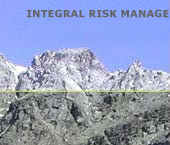| |
The goal of WP3 was: (1) To review and evaluate state-of-the-art methods of hazard mapping of debris flows, rock avalanches, and snow avalanches; (2) to assess the
sensitivity of these hazard forms to changes in environmental boundary
conditions (like climate change, increased structural protection measures,
and anthropogenic interference); and (3) to propose a best practice for
hazard mapping of rapid mass movements as an integrated component in
risk formula.
Hazard mapping is a well-known and widely applied methodology in hazard assessment and management. Hazard maps are used for spatial planning in consistence with hazardous areas, for assessing risks, and for planning of mitigation measures and intervention. In this work package current knowledge and recent approaches to mapping snow and rock avalanche and debris flows as hazards have been summarized, evaluated, and rationalized. The result is a state-of-the-art report on hazard mapping of extremely rapid mass movements in Europe. A “decalogue” lists the 10 most important subjects for hazard mapping of snow avalanches, debris flows and rock avalanches. It furthermore summarizes the present state-of-the-art and “best practice” mapping methods as well as the practical implications for risk assessment.
An essential prerequisite for hazard mapping is understanding the process dynamics and their interaction with built structures. As with forecasting, more is known about the processes involved in snow avalanches as compared to debris flow and rock avalanches. There is also more data available and the resulting hazard maps are thus more accurate. The field of hazard mapping was pioneered when snow avalanches were first mapped in the 1950s. In contrast, the development of hazard maps for rock avalanches is extremely difficult, because they occur infrequently and it is difficult to quantify run-out zones.
Not only are there discrepancies between the reliability of the hazard mapping of the different processes, but there are also considerable differences between the IRASMOS partner countries.
|
|
The long-term aim is to propose a European-wide standard for hazard mapping and quantifying hazard levels of extremely rapid mass movements. However, European harmonization of hazard mapping approaches and criteria will probably be very challenging. The reason is that hazard maps tend to have considerable economic impact on land-use planning because they influence land prices. The economic consequences of even a small modification of a map may be considerable.
Such harmonization initiatives and the future scope of the European-wide implementation of commonly accepted rules of “best practice” for effective disaster reduction with respect to extremely rapid mass movements were discussed at the “IRASMOS Round Table on Integral Risk Management” in Chamonix-Mont-Blanc, France, in January 2007. This meeting brought together stakeholders in the field of risk and crisis management with respect to rapid mass movements, such as scientists, practitioners, natural resource planners and decision-makers.
One of the main issues emphasized by many of the experts of rapid mass movements is short-term risk management. This includes early warning, artificial release (for snow avalanches) and intervention measures, which are intimately connected with settlement structures and therefore hazard mapping. As a consequence of several incidents with fatalities, particularly during the avalanche winter 1999, the central role of good documentation of the decisions made when an incident occurs became apparent. The experts agreed that, almost irrespective of country, clearer definitions of tasks and institutional responsibilities were needed. Long-term risk management, in contrast, seems to be heavily dependent on political decisions. For these a sound scientific basis is all the more important, although it takes time for them to feed into practice.
|

